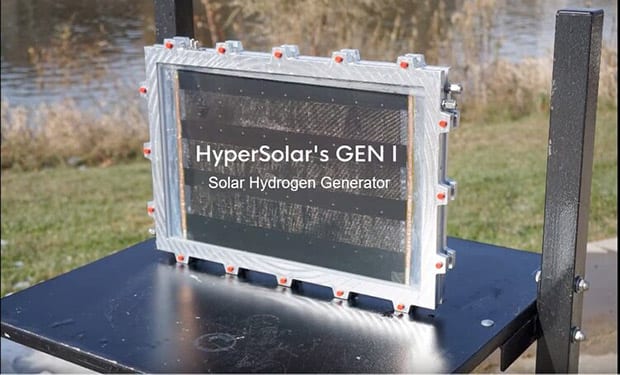‘Breakthrough Technology’ Uses Sunlight to Produce Renewable Hydrogen
The post 'Breakthrough Technology' Uses Sunlight to Produce Renewable Hydrogen appeared first on POWER Magazine.
HyperSolar Inc. said it has demonstrated a working version of a "large-scale hydrogen unit device" that it expects will lead to the production of full-sized panels for a first-generation (GEN 1) pilot plant. The company said its "breakthrough technology" uses sunlight in a "low-cost photoelectrochemical process" to separate hydrogen from water, producing "clean and environmentally friendly renewable hydrogen."
"Producing an operating version of a large-scale panel is a major milestone in the development of our pilot plant," Tim Young, CEO of HyperSolar, said in a statement on Dec. 16. "We have confidence that this achievement, together with our work with engineers, will effectively lead us to manufacture high-quality, full-scale hydrogen panels for inclusion in our pilot plant."
In June, the Santa Barbara, California-based company extended a sponsored research agreement it had with the University of Iowa through May 31, 2020. Research efforts at the university are being led by Assistant Professor Dr. Syed Mubeen and HyperSolar CTO Dr. Joun Lee. Their research is focusing on finalizing commercial processes for GEN 1 deployment and further development of GEN 2 technology. GEN 2 involves nanoparticle hydrogen production panels that are expected to have a much higher solar-to-hydrogen efficiency than GEN 1 at a lower manufacturing cost.
"We are working with multiple companies to achieve a mass production strategy for protective coatings that will protect the thousands of cells to be deployed in the pilot plant," Young said in a June statement. "University of Iowa's record-breaking development work, as demonstrated in the 1,000 hours of continuous device operation with our GEN 1 Cells, has made it possible for us to take the company to the next level."
Hydrogen ProductionAlthough hydrogen is an abundant element on Earth, it is almost always found as part of another compound, such as water (H2O) or methane (CH4). Therefore, hydrogen must be separated from the compounds that contain it before it can be used in its purest form.
The majority of hydrogen used today is produced through natural gas reforming, also known as steam methane reforming (SMR). HyperSolar claims more than 99% of today's hydrogen supply is produced by SMR. The company says, "hydrogen is the cleanest fuel in the world," but "the most-prevalent production process is obviously brown."
The U.S. Department of Energy explains the SMR process on its website. It says, "Synthesis gas, a mixture of hydrogen, carbon monoxide, and a small amount of carbon dioxide, is created by reacting natural gas with high-temperature steam. The carbon monoxide is reacted with water to produce additional hydrogen. This method is the cheapest, most efficient, and most common."
A synthesis gas can also be created by reacting coal or biomass with high-temperature steam and oxygen in a pressurized gasifier, which is converted into gaseous components-a process called gasification. The resulting synthesis gas contains hydrogen and carbon monoxide, which is reacted with steam to separate the hydrogen.
Electrolysis is another well-understood hydrogen production process. It has gained support from many power industry researchers looking to utilize renewable energy to produce hydrogen. The idea is to use wind and solar resources during periods when supply exceeds demand to produce hydrogen, rather than curtailing output. The renewable hydrogen produced could then be stored and burned in a combustion turbine when the power is needed.
Other proven hydrogen production methods include renewable liquid reforming and fermentation. Methods currently under development include high-temperature water splitting, photobiological water splitting, and photoelectrochemical (PEC) water splitting.
The HyperSolar WayHyperSolar said it aims to produce hydrogen using sunlight as the only source of energy input (Figure 1). In a presentation the company published on its website, Young, Lee, and Mubeen explain that HyperSolar's PEC-based hydrogen production system "addresses incumbent PEC technology limitations on durability, hydrogen production efficiency and system capital cost. This is achieved through innovations in light absorber materials, catalysts, and systems engineering."
According to HyperSolar, GEN 1 uses commercially available low-cost triple-junction silicon solar cells in the design of the self-contained hydrogen generating PEC cell and panel array. GEN 2 uses "easily scalable low-cost electrochemical processing for manufacturing multijunction nanoparticles for PEC production of hydrogen," the presentation says. The nanoparticles arrays will eventually replace the triple-junction silicon cells used in GEN 1. The company is targeting completion of the pilot plant as soon as late spring 2020.
"We are thrilled with the timely progress we are making, putting us within sight of our long-awaited objective," Young said.
-Aaron Larson is POWER's executive editor (@AaronL_Power, @POWERmagazine).
The post 'Breakthrough Technology' Uses Sunlight to Produce Renewable Hydrogen appeared first on POWER Magazine.
